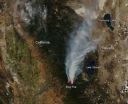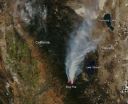(Press-News.org) A mathematical model that replicates Ebola outbreaks can no longer be used to ascertain the eventual scale of the current epidemic, finds research conducted by the University of Warwick.
Dr Thomas House, of the University's Warwick Mathematics Institute, developed a model that incorporated data from past outbreaks that successfully replicated their eventual scale.
The research, titled Epidemiological Dynamics of Ebola Outbreaks and published by eLife, shows that when applying the available data from the ongoing 2014 outbreak to the model that it is, according to Dr House, "out of all proportion and on an unprecedented scale when compared to previous outbreaks".
Dr House commented: "If we analyse the data from past outbreaks we are able to design a model that works for the recorded cases of the virus spreading and can successfully replicate their eventual size. The current outbreak does not fit this previous pattern and, as a result, we are not in a position to provide an accurate prediction of the current outbreak".
Chance events, Dr House argues, are an essential factor in the spread of Ebola and many other contagious diseases. "If we look at past Ebola outbreaks there is an identifiable way of predicting their overall size based on modelling chance events that are known to be important when the numbers of cases of infection are small and the spread is close to being controlled".
Chance events can include a person's location when they are most infectious, whether they are alone when ill, the travel patterns of those with whom they come into contact or whether they are close to adequate medical assistance.
The Warwick model successfully replicated the eventual scale of past outbreaks by analysing two key chance events: the initial number of people and the level of infectiousness once an epidemic is underway.
"With the current situation we are seeing something that defies this previous pattern of outbreak severity. As the current outbreak becomes more severe, it is less and less likely that it is a chance event and more likely that something more fundamental has changed", says Dr House.
Discussing possible causes for the unprecedented nature of the current outbreak, Dr House argues that there could be a range of factors that lead it to be on a different scale to previous cases;
"This could be as a result of a number of different factors: mutation of virus, changes in social contact patterns or some combination of these with other factors. It is implausible to explain the current situation solely through a particularly severe outbreak within the previously observed pattern".
In light of the research findings and the United Nations calling for a further $1bn USD to tackle the current outbreak, Dr House says that "Since we are not in a position to quantify the eventful scale of this unprecedented outbreak, the conclusion from this study is not to be complacent but to mobilise resources to combat the disease."
INFORMATION:
Notes to Editors.
To speak with Dr House please contact: Tom Frew, International Press Officer, University of Warwick, a.t.frew@warwick.ac.uk, +44 (0) 2476575910
Dr House is an EPSRC funded research fellow.
The paper can be viewed here: http://elifesciences.org/content/elife/early/2014/09/12/eLife.03908.full.pdf
Ebola outbreak 'out of all proportion' and severity cannot be predicted
2014-09-17
ELSE PRESS RELEASES FROM THIS DATE:
EARTH Magazine: The Bay Area's next 'big one' could strike as a series of quakes
2014-09-17
Alexandria, Va. — Most people are familiar with the Great 1906 San Francisco Earthquake and are aware of the earthquake risk posed to the Bay Area — and much of California — by the San Andreas Fault. Most people are not aware, however, that a cluster of large earthquakes struck the San Andreas and quite a few nearby faults in the 17th and 18th centuries. That cluster, according to new research, released about the same amount of energy throughout the Bay Area as the 1906 quake. Thus, it appears that the accumulated stress on the region's faults could be released in a series ...
Rooting out horse-meat fraud in the wake of a recent food scandal
2014-09-17
As the United Kingdom forms a new crime unit designed to fight food fraud — in response to an uproar last year over horse meat being passed off as beef — scientists from Germany are reporting a technique for detecting meat adulteration. They describe their approach, which represents a vast improvement over current methods, in ACS' Journal of Agricultural and Food Chemistry.
Hans-Ulrich Humpf and colleagues note that food fraud is a major global economic problem. But they also say that adding, for example, horse or pork to other meats without disclosure also can cause ...
California's King Fire east of Sacramento
2014-09-17
California's King Fire tripled in size from Monday, September 15 to Tuesday morning, September 16, and current weather conditions are doing nothing more than helping it along. The hot, drought conditions and winds have produced over 12 major fires that still burn all over California. The King Fire is just one of them. It is located east of Sacramento in the Pollock Pines community. Residents have been given mandatory evacuation orders and over 1,600 homes are currently threatened by this fire. It began Saturday September 13 and has spread rapidly through the area fueling ...
Elsevier journal Maturitas publishes position statement on breast cancer screening
2014-09-17
Amsterdam, September 17, 2014 – Elsevier, a world-leading provider of scientific, technical and medical information products and services, today announced the publication of a position statement by the European Menopause and Andropause Society (EMAS) in the journal Maturitas on the topic of breast cancer screening.
Breast cancer is the most prevalent cancer in women, with slightly more than ten percent developing the disease in Western countries. Mammography screening is a well-established method to detect breast cancer. However there are concerns about over diagnosis ...
Toward making lithium-sulfur batteries a commercial reality for a bigger energy punch
2014-09-17
A fevered search for the next great high-energy, rechargeable battery technology is on. Scientists are now reporting they have overcome key obstacles toward making lithium-sulfur (Li-S) batteries, which have the potential to leave today's lithium-ion technology in the dust. Their study appears in the ACS journal Nano Letters.
Xingcheng Xiao, Weidong Zhou, Mei Cai and their colleagues point out that the capabilities of lithium-ion batteries, which power many of our consumer electronics, as well as electric vehicles, have largely plateaued. Scientists have been pursuing ...
Environmentalists and industry duke it out over plastic bags
2014-09-17
Campaigns against disposable plastic shopping bags and their environmental impact recently scored a major win. In August, California lawmakers passed the first statewide ban on the bags, and Governor Jerry Brown is expected to sign it. But the plastic bag industry is not yielding without a fight, according to an article in Chemical & Engineering News, the weekly newsmagazine of the American Chemical Society.
Alexander Tullo, a senior correspondent with C&EN, reports that the anti-bag campaign logged its first small victory in 1990 when Nantucket became the first place ...
Mechanism behind age-dependent diabetes discovered
2014-09-17
Ageing of insulin-secreting cells is coupled to a progressive decline in signal transduction and insulin release, according to a recent study by researchers at Karolinska Institutet in Sweden. The finding, which is published in the journal Diabetes, provides a new molecular mechanism underlying age-related impairment of insulin-producing cells and diabetes.
Ageing is among the largest known risk factors for many diseases, and type 2 diabetes is no exception. People older than 65 years have an increased risk of developing type 2 diabetes if their insulin-producing cells ...
Study finds Great Barrier Reef is an effective wave absorber
2014-09-17
New research has found that the Great Barrier Reef, as a whole, is a remarkably effective wave absorber, despite large gaps between the reefs. This means that landward of the reefs, waves are mostly related to local winds rather than offshore wave conditions.
As waves break and reduce in height over reefs, this drives currents that are very important for the transport of nutrients and larvae. This reduction in wave height also has implications for shoreline stability.
The Great Barrier Reef in Australia is the largest coral reef system in the world, extending 2,300 ...
New MRI technique helps clinicians better predict outcomes following mild traumatic brain injury
2014-09-17
New Rochelle, NY, September 17, 2014—Diffusion Tensor Imaging (DTI), a specialized magnetic resonance imaging (MRI) technique that detects microstructural changes in brain tissue, can help physicians better predict the likelihood for poor clinical outcomes following mild traumatic brain injury compared to conventional imaging techniques such as computed tomography (CT), according to a new study published in Journal of Neurotrauma, a peer-reviewed journal from Mary Ann Liebert, Inc., publishers. The article is available free on the Journal of Neurotrauma website until October ...
NASA sees Tropical Storm Kalmaegi weakening over Vietnam
2014-09-17
Tropical Storm Kalmaegi made landfall on September 17 near the border of Vietnam and China and moved inland. Soon after the landfall as a typhoon, NASA's Terra satellite passed overhead and captured an image of the weaker tropical storm.
The MODIS instrument that flies aboard Aqua took a visible picture of Tropical Storm Kalmaegi on Sept. 17 at 03:35 UTC (Sept. 16 at 11:35 p.m. EDT). The image showed the center of the storm in northeastern Vietnam, just south of the China border. Kalmaegi's clouds extended north into southern China and west into Laos.
The Vietnamese ...



